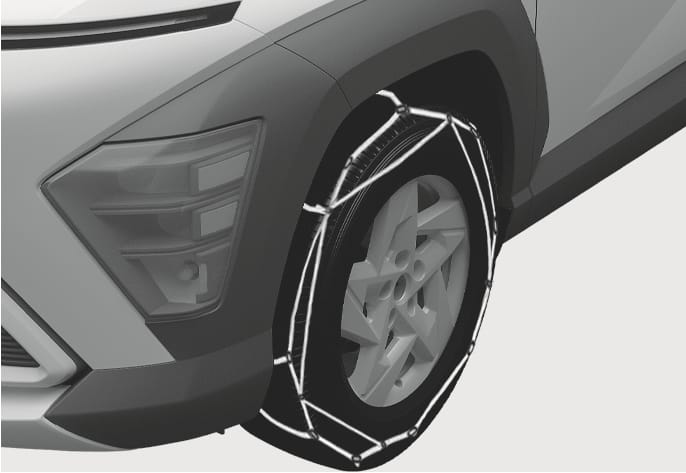Snow or icy conditions
You need to keep sufficient distance between your vehicle and the vehicle in front of you.
Apply the brakes gently. Speeding, rapid acceleration, sudden brake applications, and sharp turns are potentially very hazardous practices. During deceleration, use engine braking to the fullest extent. Sudden brake applications on snowy or icy roads may cause the vehicle to skid.
To drive your vehicle in deep snow, it may be necessary to use snow tyres or to install tyre chains on your tyres.
Always carry emergency equipment. Some of the items you may want to carry include tyre chains, tow straps or chains, a flashlight, emergency flares, sand, a shovel, jumper cables, a window scraper, gloves, ground cloth, coveralls, a blanket, etc.
Snow tyres should be equivalent in size and type to the vehicle’s standard tyres. Otherwise, the safety and handling of your vehicle may be adversely affected.
If you mount snow tyres on your vehicle, make sure to use the same Inflation pressure as the original tyres. Mount snow tyres on all four wheels to balance your vehicle’s handling in all weather conditions. The traction provided by snow tyres on dry roads may not be as high as your vehicle’s original equipment tyres. Check with the tyre dealer for maximum speed recommendations.
Do not install studded tyres without first checking local and municipal regulations for possible restrictions against their use.
-
Summer tyres are used to maximise the driving performance on dry roads.
-
If the temperature is below 7ºC (44.6ºF) or you are driving on snowy or icy roads, the summer tyres lose their brake performance and traction as the tyre grip weakens significantly.
-
If the temperature is below 7ºC (44.6ºF) or you are driving on snowy or icy roads, mount snow tyres or all-season tyres of the same size with your vehicle’s standard tyre for safe driving. Both snow and all-season tyres have M+S markings.
-
When using the M+S tyres, use tyres with the same tread produced by the same manufacturer for safe driving.
-
When driving with the M+S tyres with the lower maximum allowable speed than that of the vehicle’s standard summer tyre, be careful not to exceed the speed allowed for the M+S tyres.

2C_TireChain
As sidewalls of radial tyres are thinner than other types of tyres, they may be damaged by mounting some types of tyre chains on them. If tyre chains must be used, use genuine HYUNDAI Parts and install the tyre chain after reviewing the instructions provided with the tyre chains. Damage to your vehicle caused by improper tyre chain use is not covered by your vehicle manufacturer’s warranty.
The use of tyre chains may adversely affect vehicle handling:
-
Drive less than 30 km/h or the chain manufacturer’s recommended speed limit, whichever is lower.
-
Drive carefully and avoid bumps, holes, sharp turns, and other road hazards, which may cause the vehicle to bounce.
-
Avoid sharp turns or locked wheel braking.
-
Install tyre chains only in pairs and on the front tyres. It should be noted that installing tyre chains on the tyres will provide a greater driving force, but will not prevent side skids.
-
Do not install studded tyres without first checking local and municipal regulations for possible restrictions against their use.
Chain Installation
When installing tyre chains, follow the manufacturer’s instructions and mount them as tightly possible. Drive slowly (less than 30 km/h) with chains installed. If you hear the chains contacting the body or chassis, stop and tighten them. If they still make contact, slow down until the noise stops. Remove the tyre chains as soon as you begin driving on cleared roads.
When mounting snow chains, park the vehicle on level ground away from traffic. Turn on the vehicle Hazard Warning Flasher and place a triangular emergency warning device behind the vehicle (if available). Always place the vehicle in P (Park), apply the parking brake and turn off the engine before installing snow chains.
When using tyre chains:
-
Wrong size chains or improperly installed chains can damage your vehicle’s brake lines, suspension, body and wheels.
-
Use SAE “S” class wire chains.
-
If you hear noise caused by chains contacting the body, retighten the chain to prevent contact with the vehicle body.
-
To prevent body damage, retighten the chains after driving 0.5-1.0 km.
-
Do not use tyre chains on vehicles equipped with aluminium wheels. If unavoidable, use a wire type chain.
-
Use wire chains less than 12 mm thick to prevent damage to the chain’s connection.